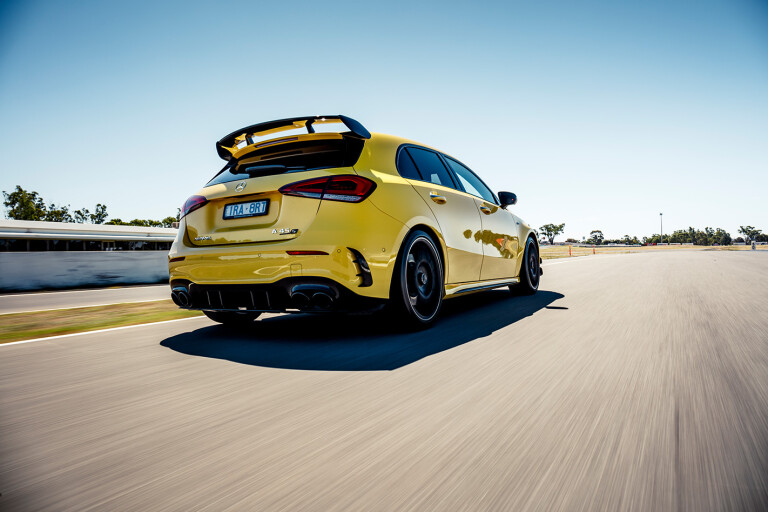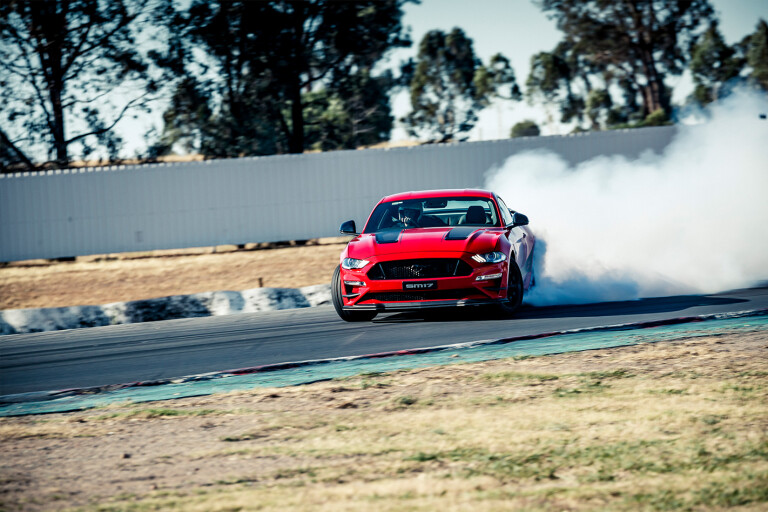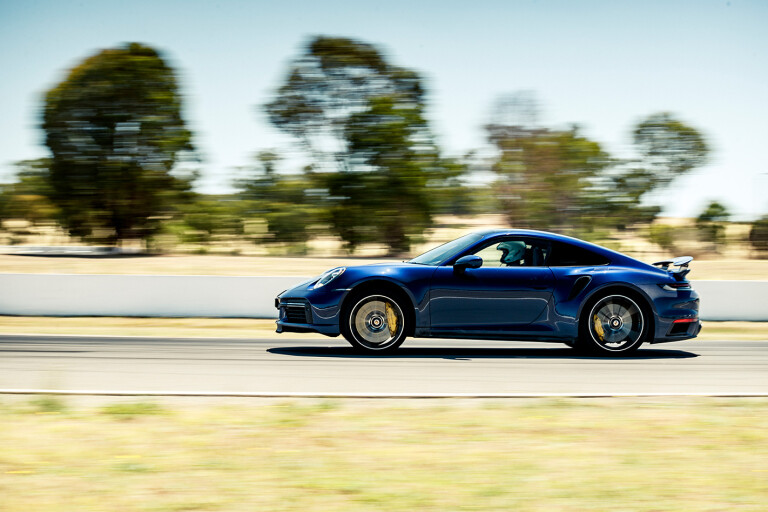
There are no slow cars anymore. Not in the performance realm, anyway.
The tail-end Charlie of this year’s Performance Car of the Year field was the Ford Fiesta ST, yet even this baby hot hatch hit 100km/h in 6.67sec and crossed the quarter in 14.73sec at 158.37km/h.
By coincidence I happen to stumble across the acceleration numbers from PCOTY 2004 and the Fiesta’s numbers put it ahead of the BMW Z4 3.0 and Subaru Liberty GT, lineball with the Nissan 370Z and fractions behind the Holden Commodore SS and Porsche Cayenne Turbo. Not bad, indeed.
It’s relatively straightforward to test, too. First-gear traction is frustratingly elusive with axle tramp an issue, but short gearing makes the most of the Fiesta’s relatively meagre grunt.
The 1.5-litre turbo triple is a great engine and the gearshift is slick, yet it’s the chassis that shines brightest. A 1min43.7sec lap time of Winton isn’t ground-breaking but the track was hot and slippery and that’s still 1.5sec quicker than its predecessor. There’s a ceiling to how hard it can be pushed but within that envelope it’s brilliant fun: agile and responsive and now with great traction courtesy of the LSD. Its only real weak spot are its brakes, which are just plain inadequate for a performance car and let down an otherwise fantastic package.
The Toyota GR Yaris has no such issues. It is one of very few road cars that is over-braked. Lap after lap they can be leant on at the latest possible moment without complaint. Toyota’s pocket rocket is equally impressive in terms of acceleration. The Fiesta’s three-cylinder is brilliant but the Yaris’s is verging on voodoo. Floor the throttle, release the clutch at 5500-6000rpm and you’ll shoot to 100km/h in 5.16sec and across the quarter mile in 13.2sec at 169.74km/h. Brisk. Sadly going around corners in an entertaining fashion isn’t such a Yaris strong suit, its front tyres yielding prematurely at every corner.

The tyres themselves don’t help – Dunlop SP Sport Maxxes aren’t known for their performance properties – squealing early and loudly but the drive system is also to blame. Even in the supposedly 30:70 Sport mode not enough drive is sent to the rear so you’re left with a frustrating wait at each apex before power can be applied again. Put simply, it wasn’t much fun and a 1min41.3 wasn’t that quick, either. Bring on the Rallye.
What was quick was the Mercedes-AMG A45 S. Launch control primed, it’ll hit 100kmh in 4.0sec all day long and jag a 3.9sec run if you’re lucky, our best run being a 3.96sec. It doesn’t peter out, either, continuing to charge across the quarter mile in just 12.09sec at 186.53km/h. And you thought the last A45 was fast! Its impressive run continued around the track with a 1:34.9sec lap, though this is with a couple of caveats.
On the plus side it was on the now-optional Pirelli P Zero Trofeo R tyres, however, on the negative there’s a suspicion that our pressure gauge might have been off, as there seemed to be too much flex in the tyre and the car felt imprecise. A switch back to the standard Michelins and the A45 S expressed its true personality. And what a personality. As well as having arguably the world’s greatest four-cylinder engine – its 155kW/litre specific output is miles ahead of anything else here – the gearbox is improved, the brakes hold up brilliantly and the chassis is lively. Trail the brakes and the rear slides on entry and then applying throttle continues to rotate the car mid-corner but with plenty of traction on exit. It’s fantastic.

Proof of the A45 S’s pace comes in the fact that it beat the 441kW Audi RS6 Avant to 100km/h, though in the Audi’s defence that’s purely because its launch control wasn’t playing ball. The process was right, the message on the dash confirmed launch control was activated but upon releasing the brake there was a substantial pause before those 600 horses took hold. Figures of 3.98sec 0-100km/h and 11.94sec at 193.67km/h certainly aren’t hanging about, but they’re a good half-second away from what the RS6 is ultimately capable of.
You might assume that a 2075kg wagon would struggle to feel at home on a race track... and you’d be right. Yet, the RS6 acquits itself better than you might imagine. It still feels big, heavy and remote to hustle, however the quick steering, adaptive dampers, clever all-wheel drive system (and all-wheel steer), massive brakes and plenty of rubber team up to make it impressively capable. When you consider that the last time an RS6/RS7 appeared at PCOTY its brakes lasted two laps and its tyres three, the fact the RS6 lapped all day without complaint is a victory.

That said, a 1:36.2sec lap time isn’t too flash, particularly when you consider that the BMW M550i, a low-fat M-car that costs almost $100K less, managed a 1:35.4sec. What’s more, the BMW was more entertaining, too. The syrupy, inconsistent weighting of the steering make inputs at best an educated guess but the chassis itself has plenty of talent and the greater rear bias of the xDrive all-wheel drive system helps both alleviate the load on the front tyres and put a smile on your face. The engine is a cracker, too, with masses of torque and a juicy V8 soundtrack.
It too suffered from launch control gremlins, though. Once again all the right buttons were pushed and right messages displayed but the pause that occurred when the brake was released was so pregnant its waters had broken. As such the M550i’s figures of 4.27sec to 100km/h and 12.21sec at 193.86km/h over the quarter are again about a half-second away from its ultimate potential. Once rolling, the BMW was every bit the match for the RS6, which makes it somewhat of a performance bargain.

But when it comes to bang for buck, the Herrod SM17 is this year’s clear king. Yes, $125K or so is massive money for a Mustang but boy, does this thing deliver. Pre-testing fears of a good time literally and figuratively going up in smoke were unfounded, the fat rear Michelin Pilot Sport 4 S tyres struggling slightly in first but then hooking up completely in second. No car generated more theatre in a straight line, the supercharger shrieking, the engine screaming, the 10-speed gearbox eating ratios as fast as you can count and the rear end squirming on each shift.
The results were jaw-dropping: 0-100km/h in 3.70sec and an 11.42sec quarter mile at 206.95km/h, making it the quickest two-wheel drive car in this year’s event. Yes, quicker even than the AMG GT R Pro. Roll-on acceleration was equally berserk, the 80-120km/h sprint taking just 1.9sec, while it stops as well as it goes, its 31.20m effort from 100-0km/h the class of the field, pipping the Cayman GTS 4.0 by just seven centimetres.

What’s more, the SM17 completed run after run with no thermal degradation, the trap speed remaining consistent. Sadly, this stamina didn’t last during the hot laps, the coolant temp skyrocketing after just one lap. This somewhat limited the enjoyment, but even so its 1:33.7 was easily fastest of the non-supercars and no car was better at the Plan B of making smoke clouds, which is just as well since Plan A – going fast – was scuppered so quickly. Even while at full power the Herrod wasn’t the handful you might expect; it would certainly oversteer at will and part-throttle response remained a challenge but it had enough ‘stop and turn’ to match its go.
The Porsche Cayman GTS 4.0 couldn’t have been more different, a scalpel to the Herrod’s broadsword. Beautiful steering, great balance, fantastic throttle response and one of the world’s greatest manual shifts makes it flattering of the novice, yet its mid-engined dynamics offer a challenge for the expert. You’d best be on your game if you’re lazy with a trailed brake or mid-corner lift in the GTS, as you’ll be dealing with oversteer before you can say “oops”, yet it’s beautifully rewarding at the limit.

There are only two issues. The first is the inconsistent ESP, or perhaps more accurately, traction control. It’s frequently intervening even when deactivated on corner exits yet if the car develops a substantial yaw moment the electronics are nowhere to be found. The other problem is the age-old gearing; it’s so tall that it took a really good exit from the last corner to need fourth down the main straight and even then it dulls the power of the otherwise wonderful 4.0-litre atmo flat-six.
As a result, it’s not actually that fast. Its 1:35.4sec lap is two seconds slower than the 718 Cayman S achieved three years ago – in better conditions but before the corner modifications that result in a faster lap, so let’s call it even – and 4.68sec to 100km/h and a 12.67sec quarter at 181.43km/h certainly isn’t slow, but it’s hardly newsworthy in 2021, either. Purists will cringe, but the Cayman GTS 4.0 will be quicker, more engaging and more enjoyable with the seven-speed PDK.
And now, the heavy hitters. We must first apologise to the Audi R8 V10 Performance. Where possible we put the pro – in this case Monsieur Reindler – in the cars first so that they’re fresh, however, the schedule dictates that the judges must also drive something and it just so happened that a number of judges had sampled the R8 prior to Reindler. The R8 is a tough cookie and isn’t the least bit fazed by plenty of track laps, but it did mean the tyres were somewhat second-hand by the time the stopwatch started, leaving Karl with armfuls of opposite lock.

As such, cut its 1:32.9sec lap time some slack – its true potential is probably 1.5-2.0sec quicker. There’s a good reason those tyres were prematurely cooked, though, as the latest R8 is fabulous fun to drive. The carbon-ceramic brakes are massively powerful, you can adjust the car’s attitude using throttle or brakes and the engine is a thing of beauty, capable of catapulting Audi’s supercar to 100km/h in 3.27sec and across 400m in 11.11sec at 205.41km/h. These numbers are actually a little slower than its predecessor, which clocked 3.18sec and 10.93sec at 209.58km/h, but this latest R8 is much more pleasant away from the circuit. About the only criticism you can level at it is that if you’re sliding it around the quattro system can be a bit inconsistent, sometimes realising your intent, at others trying to pull the car straight.
As is so often the case, the Porsche 911 Turbo S shows what’s missing. A car can only ever react to the inputs it’s given, yet the ultimate 992 somehow seems to know what you want it to do before you ask. This is a half-million dollar supercar with 478kW and 800Nm that is happy to be skidded about like an MX-5. Obviously the speeds – and consequences – are somewhat more serious but it’s so biddable and transparent in its behaviour.

It’s also ludicrously fast. Unbelievably so, to the point that even now typing this I cannot comprehend the figures the latest Turbo S spat out. Extracting them is a piece of cake: start engine, flick to Sport Plus, ESP in Sport, press the brake, flatten the throttle and release the brake. You’ll reach triple figures in 2.58sec – a PCOTY record – pass 160km/h (the old metric ton) in 5.55sec and flash through 200km/h in 8.46sec. That last figure is more than two seconds clear of any other contestant and the 10.28sec quarter mile at 217.32km/h puts the Turbo S firmly in a class of one. Launching the Turbo S is akin to being rear-ended at speed, such is the violence.
Even on the move, the massive mid-range torque hit catapults you from corner to corner in an almost alarming fashion, yet the enormous carbon-ceramic brakes are more than up to the task. Add in incredible traction and mind-bending grip and the result is a 1:30.1sec lap. And it would do it with Apple CarPlay spinning your favourite tunes and the ventilated seats keeping your bum cool.

But it wasn’t quickest, that honour goes to the incredible Mercedes-AMG GT R Pro. It’s a testament to the Porsche’s ability that its luxury grand tourer gets within a second of AMG’s hardcore, track-focused, semi-slick shod weapon, but a 1:29.3sec is a victory and let’s face it, the GT R Pro is no stripped-out racer. Regardless of the lap time, this mega Merc is one of the most rewarding and exciting track cars ever to wear number plates and every person who drove it completed more laps than was necessary.
It’s monstrously fast, clocking 3.76sec to 100km/h and an 11.48sec quarter at 207.82km/h, but like the Fiesta we started with, the engine plays second fiddle to the chassis. The switch to manually adjustable coilover suspension has been an inspired one, giving the GT a stability and predictability it’s sometimes lacked.
There’s more weight and communication to the steering, too, while the nine-stage traction control is a useful circuit tool. It also feels utterly unflustered by track work – even its tyres hold up. Despite high temperatures and a slippery track, the GT R Pro is now the quickest car we’ve ever driven at Winton.

COMMENTS